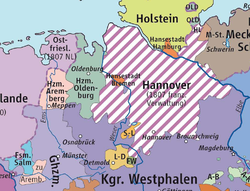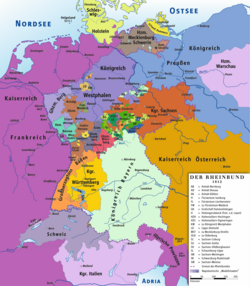History
First mentioned in the 12th century, it was named after the village of Aremberg in the Ahr Hills, located in today's Rhineland-Palatinate region of Germany.
1789
The territorial possessions of the Dukes of Arenberg varied through the ages. Around 1789, the duchy was located in the Eifel region on the west side of the Rhine and contained, amongst others, Aremberg, Schleiden and Kerpen.
However, although the duchy itself was in Germany, from the 15th century onward, the principal lands of the Dukes of Arenberg have been in what is now Belgium.
The pre-Napoleonic duchy had an area of 413 km2 (159 sq mi) and a population of 14,800. It belonged to the Electoral Rhenish Circle and was bordered by the Duchy of Jülich, the Electorate of Cologne, the Electorate of Trier, and the County of Blankenheim.
1814
After Napoleon's defeat in 1814 and the dissolution of the Confederation of the Rhine, the former Arenberg territories were divided between the Kingdom of Prussia and the Kingdom of Hanover. In both Prussia and Hanover, the dukes became local peers subordinate to the king.
1826
In 1826, the Arenberg territory in Hanover was named the duchy of Arenberg-Meppen, and it had an area of 2,195 km2 (847 sq mi) and a population of 56,700. The county of Recklinghausen, in Prussia, had an area of 780 km2 (300 sq mi) and a population of 64,700.
The Dukes of Arenberg remain a prominent Belgian aristocratic family. The immediate family members of the dukes are called by the nominal title of Prince of Arenberg. The ducal family descends agnatically from the House of Ligne.
The Forest of Arenberg is located in northeastern France, and it is famous for its cobbled roads used in the classic road cycle race Paris–Roubaix. Its areas saw extensive mining in the past.
This page is based on this
Wikipedia article Text is available under the
CC BY-SA 4.0 license; additional terms may apply.
Images, videos and audio are available under their respective licenses.





